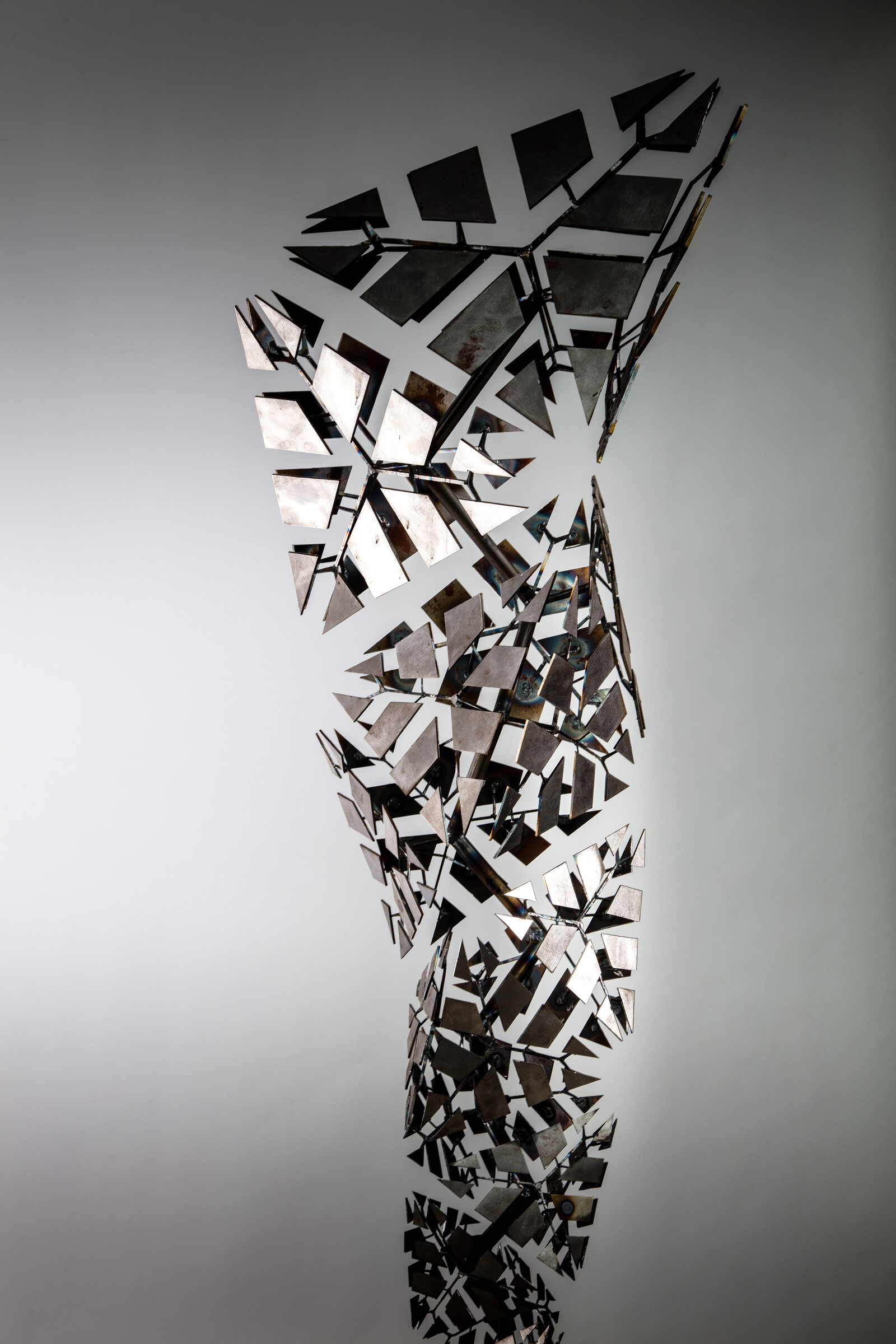After the Explosion, Before the Collapse
September 13–October 27, 2018
14 St George Street
London W1S 1FE
UK
Victoria Miro is delighted to announce an exhibition of new works by Conrad Shawcross: After the Explosion, Before the Collapse features new Fracture sculptures and two new mechanical works, in addition to a sequence of unique photographic prints created by firing a laser through a series of faults in fragments of glass. United by an aesthetic akin to that of scientific models, the abstract works on view continue to deal with notions of time, entropy and disappearance.
The exhibition marks a significant development of Conrad Shawcross’s celebrated Paradigm sculptures. The Paradigms are an ongoing exploration of the tetrahedron—geometrically a four-sided non-tessellating form and conceptually the symbol of an indivisible unit of matter. As a building block, the tetrahedron behaves as an irrational number, creating sequences that in theory, extend into infinity without repetition. Major examples include Paradigm, 2016, a permanent installation commissioned by the Francis Crick Institute in King’s Cross, which is one of the tallest public sculptures in central London. The title of the works refers to the notion of the paradigm shift—a leap of imagination that jolts scientific enquiry forwards and collapses pre-existing notions of what is true—identified by the American physicist and philosopher Thomas Kuhn (1922–96).
The previous series of Paradigms embody the epistemological metaphor of the ascending stack and display a visceral physicality. By contrast, these latest sculptures, known as Fractures, are far more ethereal, and seem almost to disappear as they rise up and expand. While strikingly distinct both conceptually and aesthetically, the Fractures still obey the same geometric parameters and constraints, but also contain a central helical stem. This twisting spine supports a series of branches which in turn support hundreds of fragments that, as a whole, echo the once solid surface of the Paradigm skin. For Shawcross, an aesthetic of the designed, scientific and the rational serves as a device to cloak more poetic, philosophical and metaphysical themes, which are foregrounded in these new works. A variety of surfaces and materials articulate the field array; dark surfaces counterpoint the reflective or semi-transparent skin to create interference and disruptive reactions to light, all of which further accentuate feelings of dissolution and perplexity, drawing viewers into an ever-changing experience as they move among the works.
Speaking about the Fractures, Shawcross notes that “A potential way to think of them is as some sort of complex model by a scientist or a mathematician. While they appear to be functional or of rational intent, their meaning remains elusive. They contain a temporal element that seems to convey growth, entropy or collapse. On one side they could represent a complex chemical such as a protein chain or amino acid, but to complicate this interpretation, a strong sense of the passage of time runs through the form. They perhaps capture an instant after an explosion but before the collapse of the system that they chart, like a Muybridge sequence; the story of a complex system and its expansion from birth to death. One of the key ways that scientists talk about time is in the dispersal of heat, that time is defined by energy dissipating. In this way, these new works also contain a sense of expansion or a loss of heat, which in turn relates to the expansion of the universe and its possible contraction. This preoccupation aligns with the concerns of my previous works, such as the early rope machines.”
A substantial new book, focusing on key themes in Shawcross’s art and detailing many of his most ambitious public projects to date, will be published by Elephant Publishing this autumn.
About the artist
Conrad Shawcross was born in 1977 in London, where he currently lives and works.
Recent London commissions include The Interpretation of Movement (a 9:8 in blue) (2017) as part of the Terrace Wires project with the Royal Academy of Arts and St Pancras International; The Optic Cloak (2016) an architectural intervention for the Greenwich Peninsula; Three Perpetual Chords (2015), a permanent sculpture commissioned for Dulwich Park; The Dappled Light of the Sun (2015), first installed in the RA Courtyard for the Summer Exhibition in 2015; and Paradigm (2016) a permanent installation which marked the inauguration of The Francis Crick Institute in King’s Cross.
In 2012 he was invited to create works inspired by Titian’s masterpieces for Metamorphosis: Titian 2012 a collaboration between The National Gallery and Royal Ballet. Solo exhibitions at institutions include ARTMIA Foundation, Beijing and the Science Museum, London.


